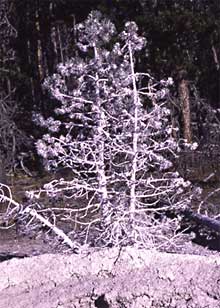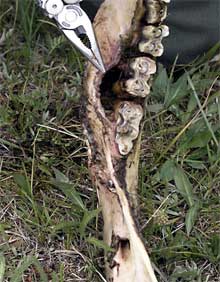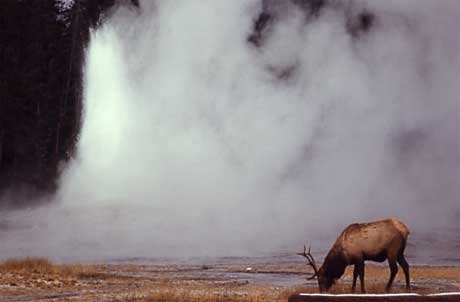|
Lobby > Exhibits > Hot Spring Ecology > Wildlife > Hydrothermal Hazards
Wildlife
HYDROTHERMAL HAZARDS
The teeth of elk and bison inhabiting thermal areas decay much faster than those of ungulates living elsewhere in the park. The water, soil, and plants of such areas often contain elevated levels of fluoride, which is passed to grazing animals through the vegetation they eat. It’s interesting to note that a certain amount of fluoride is necessary for healthy teeth but too much is harmful.
 Hot springs and geysers also coat the surrounding vegetation with deposits of silica—one of the main ingredients of glass. When an elk or bison eats a fresh sedge salad found around a hot spring, chances are good that the leaves have a silica dressing. Imagine what your teeth would look like if you were to grind them with glass every day instead of brushing them! Hot springs and geysers also coat the surrounding vegetation with deposits of silica—one of the main ingredients of glass. When an elk or bison eats a fresh sedge salad found around a hot spring, chances are good that the leaves have a silica dressing. Imagine what your teeth would look like if you were to grind them with glass every day instead of brushing them!
 When the teeth of an ungulate decay, the animal can’t eat or digest food effectively. This leads to a weakened condition and decreases the animal’s ability to defend itself against predators. The accelerated tooth decay mimics the effects of old age. Researchers estimate that the ungulates living year-round in thermal areas shorten their life spans by as much as four years. When the teeth of an ungulate decay, the animal can’t eat or digest food effectively. This leads to a weakened condition and decreases the animal’s ability to defend itself against predators. The accelerated tooth decay mimics the effects of old age. Researchers estimate that the ungulates living year-round in thermal areas shorten their life spans by as much as four years.
Next |
1 > 2 > 3 > 4 > 5 > 6 | Next Section: Plants

|


 Hot springs and geysers also coat the surrounding vegetation with deposits of silica—one of the main ingredients of glass. When an elk or bison eats a fresh sedge salad found around a hot spring, chances are good that the leaves have a silica dressing. Imagine what your teeth would look like if you were to grind them with glass every day instead of brushing them!
Hot springs and geysers also coat the surrounding vegetation with deposits of silica—one of the main ingredients of glass. When an elk or bison eats a fresh sedge salad found around a hot spring, chances are good that the leaves have a silica dressing. Imagine what your teeth would look like if you were to grind them with glass every day instead of brushing them!
 When the teeth of an ungulate decay, the animal can’t eat or digest food effectively. This leads to a weakened condition and decreases the animal’s ability to defend itself against predators. The accelerated tooth decay mimics the effects of old age. Researchers estimate that the ungulates living year-round in thermal areas shorten their life spans by as much as four years.
When the teeth of an ungulate decay, the animal can’t eat or digest food effectively. This leads to a weakened condition and decreases the animal’s ability to defend itself against predators. The accelerated tooth decay mimics the effects of old age. Researchers estimate that the ungulates living year-round in thermal areas shorten their life spans by as much as four years.

